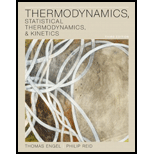
A bottle at 325 K contains an ideal gas at a pressure of
Want to see the full answer?
Check out a sample textbook solution
Chapter 2 Solutions
Thermodynamics, Statistical Thermodynamics, & Kinetics
- One mole (1.0 mol) of an ideal gas is initially at T1 = 298 K and has volume V1 = 2.0 L. It is then reversibly expanded to final volume V2 = 3.0 L. Assume Cp = 5/2 R and Cv = 3/2R. a) Calculate the following if the expansion is isothermal: 1) ΔT 2) q 3) w 4) ΔU 5) ΔH b) Calculate ΔT–ΔU if the expansion is adiabatic instead of isothermal.c) Calculate the initial pressure and two final pressures for the process in a) & b).d) On a single set of axes, sketch a pressure–volume plot for each of the two processes in a) & b). Label the area that corresponds to the work for each process.arrow_forwardA 1.65 mole sample of an ideal gas for which Cv, m = 3/2 R undergoes the following two-step process: (a) From an initial state of the gas described by T = 14.5 oC and P = 2x104 Pa, the gas undergoes isothermal expansion against a constant external pressure of 1.0x104 Pa until the volume has doubled. (b) Then the gas is cooled to constant volume. The temperature drops to -35.6 oC. Calculate q, w, ΔH, ΔU for each step and for the overall process.arrow_forwardLimestone stalactites and stalagmites are formed in caves by the following reaction:Ca2+(aq)+2HCO−3(aq)→CaCO3(s)+CO2(g)+H2O(l)Ca2+(aq)+2HCO3−(aq)→CaCO3(s)+CO2(g)+H2O(l)If 1 molmol of CaCO3CaCO3 forms at 298 KK under 1 atmatm pressure, the reaction performs 2.47 kJkJ of P−VP−V work, pushing back the atmosphere as the gaseous CO2CO2 forms. At the same time, 38.75 kJkJ of heat is absorbed from the environment. What is the value of ΔHΔH for this reaction? Express your answer using four significant figures.arrow_forward
- You have a gas held isothermally at 297 K whose volume changes from 0.2 m^3 to 9.0 m^3, what is the change in internal energy? Use the fact that the internal pressure of this gas is approximately constant at 100 MPa under these conditions.arrow_forward1. A chemical reaction takes place in a container fitted with a piston of cross-sectional area 75.0 cm2 . As a result of the reaction, the piston is pushed out through 25.0 cm against an external pressure of 150 kPa. Calculate the work done by the system.arrow_forward5. A sample consisting 3.0 moles of a perfect gas molecules initially at thermal equilibrium with the surroundings 273 K undergoes an irreversible isochoric change to a final temperture of 207 K. Calculate ∆Ssys, ∆Ssurr, and ∆Stotal for the process. Assume Cp,m is 7/2 R throughout the entire temperature range.arrow_forward
- Cp− ̄Cv=T ̄V β^2/κ reduces to ̄CP− ̄CV=R for an ideal gas.arrow_forwardA 2.5 mol sample of an ideal gas with a molar specific heat Cv=5/2R always starts at pressure 1.50*105 Pa and temperature 350K. The gas is compressed adiabatically to 200kPa. Final pressure Pf = 200kPa Final volume Vf = 39.5L Final temperature Tf = 380K a) Determine the change in internal energy of the gas (ΔEint, in J). b) Determine the energy added to the gas by heat (Q, in J). c) Determine the work done on the gas (W, in J).arrow_forward2.0 mol of CO2 gas (assumed to be a perfect gas with Cv,m = 28.8 JK-1mol-1) is in a cylinder with a massless piston of cross-section 100 cm2 at 10°C and 9.0 atm. The gas expands adiabatically against an external pressure of 1.5 atm until the piston moves 15 cm. Calculate (a) q; (b) w; (c) ΔU; (d) ΔT; (e) ΔS for this process.arrow_forward
- List the sets of conditions that allows dS,dU,dH and dG of a process in a system acts as a spontaneity condition.arrow_forward4. A sample consisting of 150 g of CO molecules at 300 K is expanded isothermally from an initial pressure of 5.0 bar to a final pressure of 2.0 bar. Calculate q, w, ∆U, ∆H, ∆Ssys, ∆Ssurr, and ∆Stotal for the process two ways: (a) reversibly and (b) irreversibly against a constant pressure of 2.0 bar. Cp,m is constant at a value of 29.14 J/mol* K, and temperature of the surroundings is 273 K. State whether each process is spontaneous.arrow_forwardA mole of a diatomic gas at 0.1 m³ is expanded isothermally at 298 Kelvins to 1.0 m³ bar against a constant external pressure of 0.5 bar. Which of the following statements is true? A. q=w B. q= -w C. ∆H= ∆U D. ∆H> ∆Uarrow_forward
 Physical ChemistryChemistryISBN:9781133958437Author:Ball, David W. (david Warren), BAER, TomasPublisher:Wadsworth Cengage Learning,
Physical ChemistryChemistryISBN:9781133958437Author:Ball, David W. (david Warren), BAER, TomasPublisher:Wadsworth Cengage Learning,
